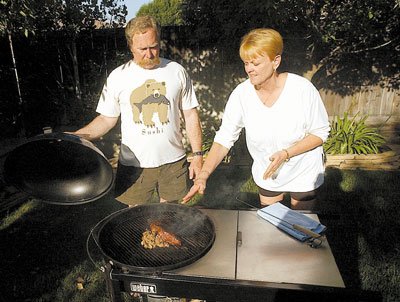Barbecue is more than just a tasty way to cook; it’s an art unto
itself
Phyllis Swallow and her husband Jack don’t have a lot of time to spend laboring over their supper in the evening.
She’s in her 28th year as a real estate agent and he owns Phone Jack, a service that offers customers phone systems and installation, so when they do arrive back at their Ridgemark home, it’s time to fire up the grill for what Phyllis Swallow calls “cooking for lazy people.”
The Hollister couple grills their own health-conscious meals about 80 percent of the time, Phyllis Swallow said, and serves them up alongside green salads she mixes in large batches every three days.
For the most part, it’s simple fare, she said, but who said good taste had to be too complex?
The Swallows are two of an elite group: South Valley barbecue masters. While barbecuing may be an easy cooking method to learn, it’s a difficult one to master.
And it’s more than a handy way to avoid heating up the kitchen during hot summer nights.
It also offers busy families a speedy way to cook up a delicious, nutritious meal without breaking the bank. But to do barbecue right, take some tips from the experts.
Secrets of the pros
The grill is just one part of the process for creating the mouthwatering tri-tip the Swallows are about to enjoy for dinner.
“Quality is really what you’re going to taste,” said Phyllis Swallow, who noted they have put their skills to use barbecuing for members of the Chamber of Commerce. “You don’t want to skimp on the meat if you’re going to be barbecuing. My husband also insists that we don’t use charcoal lighter fluid to get the fire going. We use a gas starter or we use a cone packed with newspaper to get the fire going instead, because when you use the starter you can really taste it in the food.”
And flavors shouldn’t be competing for attention, according to Gary Goularte, an active member of the volunteer community in Hollister who, at one point, owned his own catering service in town.
He gave it up six years ago because of back trouble, but doesn’t mind giving younger cooks a bit of advice.
One thing anyone can do to separate oneself from other cooks is to have a signature item. Instead of attempting to make everything perfect – the best meat, the strongest garlic bread, the freshest salad – concentrate on making one item really well, preferably the meat.
“You always want just one thing that people will walk away talking about,” said Goularte.
Goularte knows how to keep folks talking. He developed his entire line of original recipes through trial and error while grilling for co-workers and volunteering at community events. Their brutally honest commentary helped him to hone his style. Now retired, he gives the recipes away, telling fans that he’d rather have people send donations to the area’s Special Education programs than pay him for a cookbook.
Tricks of the trade
Goularte’s recipes contain some unusual ingredients. He employs everything from popcorn topping to maple pancake syrup in the creation of his barbecue sauce. One thing that none of his recipes contain is onion. He’s allergic to the pungent bulbs.
Unexpected ingredients and methods are a hallmark among good barbecue chefs. Swallow has found natural flavor is best enhanced with a little know-how and a little willingness to experiment. Her ribs are just one example of the “practice makes perfect” method she’s has devised.
Rather than having her husband cook ribs fully on the grill, she takes them back when they’re half done and bakes them at 300 degrees for two hours, gently resting on a raised wire rack over a pool of white wine. As the ribs cook, it slowly evaporates, infusing the meat, which nearly falls off the bone with added flavor.
The real key to success, though, is balance, said Goularte.
“People like opposites,” he said. “It’s all about pairing the salty with the sweet, the bitter with the savory, so you get both of them in the same bite.”
The type of grill you use can also influence the flavor of a meat. The Swallows have two grills in their back yard: a gas-powered grill for chicken and ribs, and an old-fashioned Weber for smoky beef.
If you’d like to grill like a pro, but haven’t exactly earned your cooking merit badges, do the next best thing: take a recipe from the pros.
Here are a couple to get you started:
Phyllis and John Swallow’s Stuffed Tri-Tip
Step 1: Using a long, thin-bladed knife, make a pocket in the meat with only a two-inch opening and set aside.
Step 2: Fry sausage until almost done, drain and then add mushrooms and seasonings. Cook until sausage is completely done. Cool.
Step 3: Chop sausage into small pieces if not already broken up from cooking. Add cheese and mix well. Stuff cavity of the tri-tip full. If opening becomes too large from stuffing, a skewer may be used to hold it closed.
Step 4: Barbecue for 20 minutes on each side. Be careful if cheese starts to run out, as meat may burn. Make sure the opening is well closed. Remove from barbecue and wrap in foil for 15 minutes. Remove foil, slice and serve.
Gary Goularte’s BBQ Sauce
Yield: About 3 1/2 gallons
2 #10 cans Heinz catsup
1/2 gallon Pace medium picante sauce
2 cups red wine vinegar
2 cups Worcestershire sauce
2 cups liquid smoke
1 cup lemon juice
4 cups butter flavored oil (like popcorn topping)
1 cup crushed garlic
3 cups maple flavored pancake syrup
1/2 cup dried mustard
1/2 cup black pepper
1/4 cup chili powder
2 Tbsp. whole celery seed
Step 1: Mix all the ingredients together. Warm in a double boiler so the flavors can infuse, but do not boil. If boiled, it will become bitter.
Step 2: Use immediately as marinade and brush-on sauce or store it for up to six months in the refrigerator, just like catsup.













